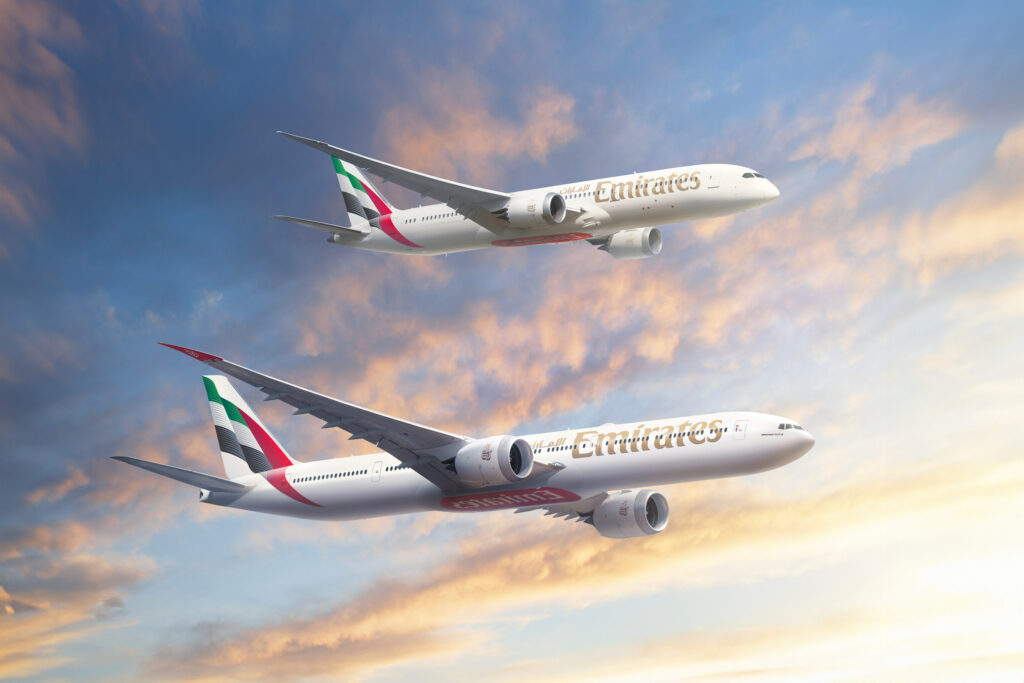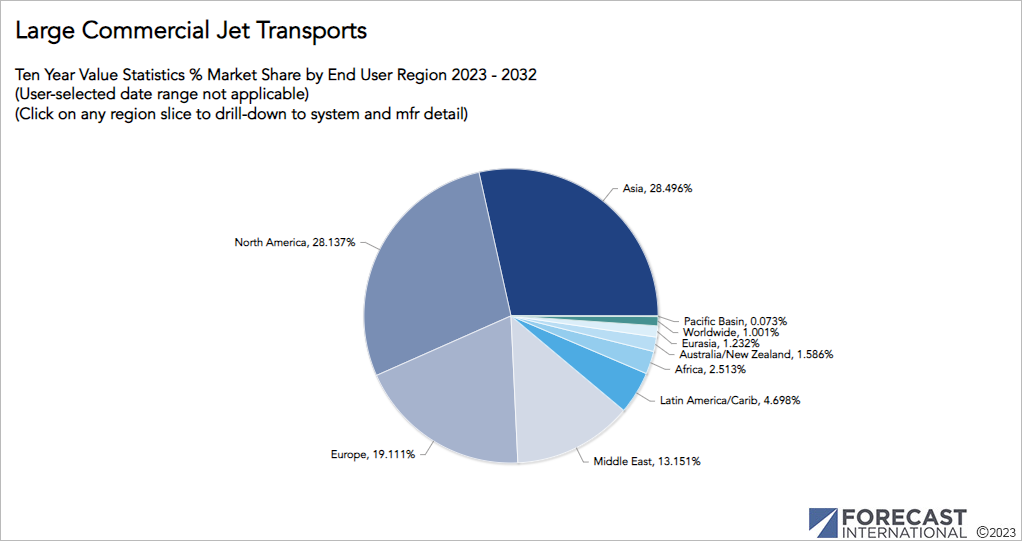Show underscores aerospace is alive and healthy in the Middle East /// Boeing takes orders crown in strong week – new all-time backlog record-high to follow soon

With the two ongoing major conflicts in Ukraine and Gaza looming in the background, Dubai Airshow 2023, the largest aerospace event in the Middle East took place last week in the UAE at Al Maktoum International Airport, also known as Dubai World Central (DWC). More than 100,000 people and 1,400 exhibitors were in attendance with over 180 aircraft on flying and static display. Dubai Airshow also featured nine industry conference tracks led by more than 300 speakers as well as several official events, including the exhibitor party, golf tournament and gala dinner. As widebody jet orders worth well over $60 billion at list prices were announced, Saudi and Turkish carriers made progress on massive future orders from the sidelines. Boeing booked a total of 214 firm orders plus a significant number of options well ahead of Airbus’ 55 firm bookings.
The Middle East is not surprisingly an important region for the aerospace industry and Boeing scored an important win at the show by taking the orders crown ahead of Airbus. “You can’t get a better geographic location than the Middle East, connecting 80% of the world’s population within an 8-hour flight,” said Darren Hulst, Vice President of Commercial Marketing at Boeing. Thanks to a solid orders haul at the show, the U.S. aerospace giant will most likely set a new all-time orderbook record next month when Dubai and other November bookings are added. At the end of October, Boeing reported a firm backlog of 5,866 aircraft and, adding the 214 firm Dubai orders (assuming all orders will be booked end of November and no new orders other than the 214 placed in Dubai), we arrive at 6,080 aircraft in backlog minus an estimated 45-50 November deliveries – and we end up with a Boeing backlog as of 30 November of approximately 6,030 aircraft. Boeing therefore is looking set to not only surpass its old orderbook record of 5,964 aircraft set in August 2018, but will likely also take it one step further and surpass the 6,000 aircraft backlog mark.
Adding, to the good news for Boeing, while unrelated to Dubai Airshow, news broke that China is reportedly considering to lift their ban on commercial jet purchases from the company. This month appears to be a key turning point for Boeing following five extremely challenging years that included the 737 MAX crashes and subsequent grounding, the COVID downturn, issues with 787 Dreamliner production, and prolonged supply chain issues.
Already before the official opening of the event on Monday last week, the first major orders hit the wire. The highlight of the show was Emirates’ major order for 90 777X jets comprised of 35 777-8s and 55 777-9s. At list prices (before discounts), the order is valued at $52 billion. With their newest order, Emirates expanded its 777X backlog to 205 jets. The airline also added five more 787-10 Dreamliners, while converting 30 787-9s to 20 787-8s and 10 787-10s. “Emirates is the biggest operator of Boeing 777 aircraft, and today’s order cements that position,” said Sheikh Ahmed bin Saeed Al Maktoum, Chairman and Chief Executive, Emirates Airline and Group. “This order is an incredible vote of confidence in Boeing’s highly efficient widebody family and the versatility of our 777X and 787 airplanes to meet Emirates’ needs for global long-haul travel,” said Stan Deal, President and CEO of Boeing Commercial Airplanes. In Dubai, Boeing had the 787-9 and 777X on display.

For Emirates, agreements at the show were not limited to placing large aircraft orders. Over the course of the week, the airline also announced the construction of a new $950 million engineering facility at DWC, the signing of a $1.2 billion deal with Safran to provide a wide range of services for new Emirates A350 and 777X aircraft as well as the existing 777-300 fleet, the signing of agreements valued at over $1.5 billion to extend the longevity of the A380 fleet along with several other deals. By the early 2030s, plans call for a 350-aircraft-strong Emirates fleet and 400 cities will be added to Dubai’s foreign trade map.
Also on the first day of the show, Emirati low-cost airline, FlyDubai, announced an order for 30 Boeing 787-9 Dreamliners valued at $11 billion. SunExpress, a joint venture between Turkish Airlines and Lufthansa, placed a large order for 45 737 MAX single-aisle jets with options for 45 additional aircraft. The deal comprises 28 737-8 and 17 737-10 models. Finally, Royal Air Maroc and Royal Jordanian announced orders for four and two 787-9 Dreamliners.

Airbus made a big splash in Dubai and had the following aircraft on display: A321-211 P2F, A321neo, A330-800, A400M Atlas CMk1, A400M Atlas, C295M, and the ACJ TwoTwenty, which is the bizjet version of the A220-100. On the first day of the show, Airbus announced that airBaltic, the flag carrier of Latvia, will become the largest A220 customer in Europe after confirming a new order for an additional 30 A220-300s, taking the airline’s total firm orderbook to 80 aircraft. The airline was also the launch customer for the A220-300 and is the largest operator in the world. Also, Turkish Airlines was looking set to announce a huge 355-aircraft purchase from Airbus, including 250 A321neos. Prior to the show, it was announced that Turkish Airlines and Airbus had reached an agreement in principle for a “significant commercial aircraft order”. Turkish Airlines is reportedly looking to buy 75 A350-900s, 15 A350-1000s, five A350 freighters as well as 250 A321neos, in addition to 10 A350-900s for which terms have already been agreed upon (added to Airbus’ backlog in November). The order has been on the drawing board for many months and some had expected it to be announced already at this year’s Paris Air Show.
Riyadh Air, a planned second flag carrier of Saudi Arabia is also in the market for aircraft but did not place any orders in Dubai. The emergence of Riyadh Air will be a challenge for Emirates and Qatar Airways, the Middle East’s biggest airlines, which dominate the transit passenger market. In March, Riyadh Air announced an order for up to 72 Boeing 787-9 Dreamliners with plans to expand much further. On the first day of the show, the airline’s CEO stated that his company would announce a very large order for narrowbody aircraft “in a number of weeks’ time” following a review of bids from Airbus and Boeing.
On Tuesday (day 2), Ethiopia’s flag carrier, Ethiopian Airlines announced it had agreed to order 11 Boeing 787-9 Dreamliners and 20 737-8 MAX jets with an opportunity for 15 and 21 additional jets, respectively. Also on Tuesday, Kazakhstan’s SCAT Airlines placed an order for seven 737-8 MAX aircraft. Meanwhile, Airbus received an order from EGYPTAIR for 10 A350-900 aircraft. French turboprop manufacturer, ATR, booked an order for 10 ATR 72-600s for Abelo, a turboprop-focused leasing firm, along with options for an additional 10 aircraft.
On Wednesday (day 3), Ethiopian Airlines signed a memorandum of understanding (MoU) with Airbus for 11 A350-900s to be added to its existing fleet. On day 4, Emirates signed an order for an additional 15 A350-900s, taking its total orders for this model to 65. According to industry sources, the order was initially on hold due to last-minute negotiations concerning the terms of an engine deal with Rolls-Royce.
Business aviation players also flocked to Dubai. Gulfstream, notably missing from last month’s BACE in Las Vegas, put the G500 and G700 on display, while archrival Bombardier presented their Challenger 3500 and Global 7500 business jets. Dassault brought along their Falcon 10X mock-up and Falcon 2000LXS, while Pilatus showcased the PC-24 Super Versatile Jet. Embraer had their Praetor 600 and Phenom 100EV business jets on display and, in addition, the company’s commercial and military businesses showcased the E195-E2, A-29 Super Tucano and C-390 Millenium. Also, many military aircraft were on display at the show, including the Eurofighter Typhoon and Dassault Rafale fighter jets.
Future Perspectives for Air Travel and Civil Aircraft Demand in the Middle East
Following a busy week for the industry in Dubai, at Forecast International we predict that aerospace in the Middle East will continue to grow at a healthy pace for the remainder of this decade and beyond. Taking a deep dive into our Civil Aircraft Forecast product, we currently predict that airlines in the Middle East will account for 13.2% of the value of world large commercial jet transport deliveries worldwide from 2023 to 2032. While only accounting for some 7-9% of world deliveries, 45-47% of commercial jets purchased in the Middle East over the next two decades are expected to be widebodies. It is therefore no surprise that aircraft such as the 777X, 787 and A350 will continue to be in high demand in the region in the future.

Turning to the market for business jet aircraft, over the next 10 years, the Middle East will account for nearly 8% of the market (value share) and is the fourth most important world region.

In line with our forecasts for the Middle East region, in the company’s annual Commercial Market Outlook (CMO), Boeing is forecasting 2.8% average annual economic growth (GDP) in the Middle East out to 2042, annual passenger growth of 6.0%, and fleet growth of 4.5%. In the coming 20 years, 2,990 large commercial jets will be delivered in the Middle East or 7.3% of all large commercial aircraft shipments worldwide. This will result in an increase in the fleet from 1,365 aircraft today to 3,310 aircraft by 2042. According to Boeing, airlines in the Middle East have increasingly expanded their influence and reach, transforming the region into an international air transit hub. One of the interesting things about air travel in the Middle East is the importance of the high-volume transit traffic passing through the region. The most prominent example is Dubai and Emirates now ruling over a widebody empire of A380s and 777s – and soon also 787s and A350s. The widebody dominance is one of the unique things about Middle East aircraft demand. Boeing forecasts that 45% of the 2,990 aircraft to be delivered in the region over the next two decades will be wide-body jets. No region in the world has a higher percentage of widebodies entering the fleet. This also means that the Middle East’s value share will be significantly higher than the 7.3% share of commercial jet deliveries.
Boeing Commercial Market Outlook: World Large Commercial Jet Deliveries 2023-42

Out to 2042, in their Global Market Forecast (GMF), Airbus predicts that 3,420 large commercial passenger and cargo aircraft (>100 passengers) will be delivered to airlines based in the Middle East, of which 46.8% are wide-body jets. According to Airbus, the Middle East will account for 8.4% of world deliveries out to 2042.
Airbus Global Market Forecast: World Large Commercial Jet Deliveries 2023-42

According to the International Air Transport Association (IATA), airlines in the Middle East, experienced a 27% increase in traffic during the month of September compared to the same month last year. Air travel has come back strong following COVID and will set new records this year and beyond, which translates into strong demand for new efficient aircraft in the Middle East and elsewhere.
References:
- https://www.dubaiairshow.aero/
- https://flightplan.forecastinternational.com/2023/11/15/airbus-and-boeing-report-october-2023-commercial-aircraft-orders-and-deliveries/
- https://www.boeing.com/commercial/market/commercial-market-outlook/
- https://boeing.mediaroom.com/2023-11-11-Boeing-Middle-East-fleet-to-more-than-double-by-2042-with-new-technology-widebodies-leading-the-way
- https://boeing.mediaroom.com/2023-11-13-Emirates-Orders-Nearly-100-More-Boeing-Widebody-Airplanes
- https://boeing.mediaroom.com/2023-11-13-SunExpress-to-Buy-up-to-90-Boeing-737-MAX-Jets-to-Fuel-Robust-Growth
- https://boeing.mediaroom.com/2023-11-13-flydubai-Orders-30-Boeing-787-Dreamliners,-Its-First-Widebody-Airplanes
- https://boeing.mediaroom.com/2023-11-13-Royal-Jordanian-Grows-its-Long-Haul-Fleet-With-Order-for-Boeing-787-9-Dreamliners
- https://boeing.mediaroom.com/2023-11-13-Royal-Air-Maroc-Confirms-Order-for-Two-Boeing-787-Dreamliners
- https://boeing.mediaroom.com/2023-11-14-Ethiopian-Airlines-Agrees-to-Landmark-Order-for-Up-to-67-Boeing-Jets
- https://boeing.mediaroom.com/2023-11-14-SCAT-Airlines-Announces-Order-for-Seven-Boeing-737-MAX-Jets-to-Connect-New-Markets
- https://www.airbus.com/en/products-services/commercial-aircraft/market/global-market-forecast
- https://www.airbus.com/en/newsroom/press-releases/2023-11-airbaltic-to-become-largest-airbus-a220-customer-in-europe
- https://www.airbus.com/en/newsroom/press-releases/2023-11-ethiopian-airlines-in-it-for-the-long-haul-commits-to-a-further-11
- https://www.airbus.com/en/newsroom/press-releases/2023-11-emirates-orders-15-more-airbus-a350-900s
- https://www.reuters.com/business/aerospace-defense/airbus-agreement-reached-principle-turkish-airlines-order-2023-11-13/
- https://www.reuters.com/business/aerospace-defense/dubai-displays-strength-air-show-rivals-tease-deals-2023-11-17/
- https://www.aerotime.aero/articles/turkish-airlines-eyes-355-aircraft-in-new-airbus-order
- https://www.aa.com.tr/tr/ekonomi/thy-tarihindeki-en-buyuk-ucak-alimi-icin-airbus-ile-gorusuyor/3050974
- https://simpleflying.com/airbus-vs-boeing-dubai-airshow-2023/
- https://www.dubaiairshow.aero/flying-display-programme
- https://www.dubaiairshow.aero/aircraft-list
- https://www.dubaiairshow.aero/exhibitor-list-exhibitor
- https://www.dubaiairshow.aero/official-events
- https://aviationsourcenews.com/airshow/dubai-airshow-overall-recap-emirates-has-had-a-big-week/
- https://apnews.com/article/dubai-air-show-israel-hamas-russia-ukraine-d2ca068f0c88592c60eb9f11737baa46
- https://gulfnews.com/business/aviation/dubai-airshow-2023-takes-off-live-updates-from-day-1-at-one-of-worlds-biggest-airshows-1.1699809819184
- https://www.aerosociety.com/news/dubai-air-show-2023-day-zero/
Kasper Oestergaard is an expert in aerospace & defense market intelligence, fuel efficiency in civil aviation, defense spending and defense programs. Mr. Oestergaard has a Master's Degree in Finance and International Business from the Aarhus School of Business - Aarhus University in Denmark. He has written four aerospace & defense market intelligence books as well as numerous articles and white papers about European aerospace & defense topics.



